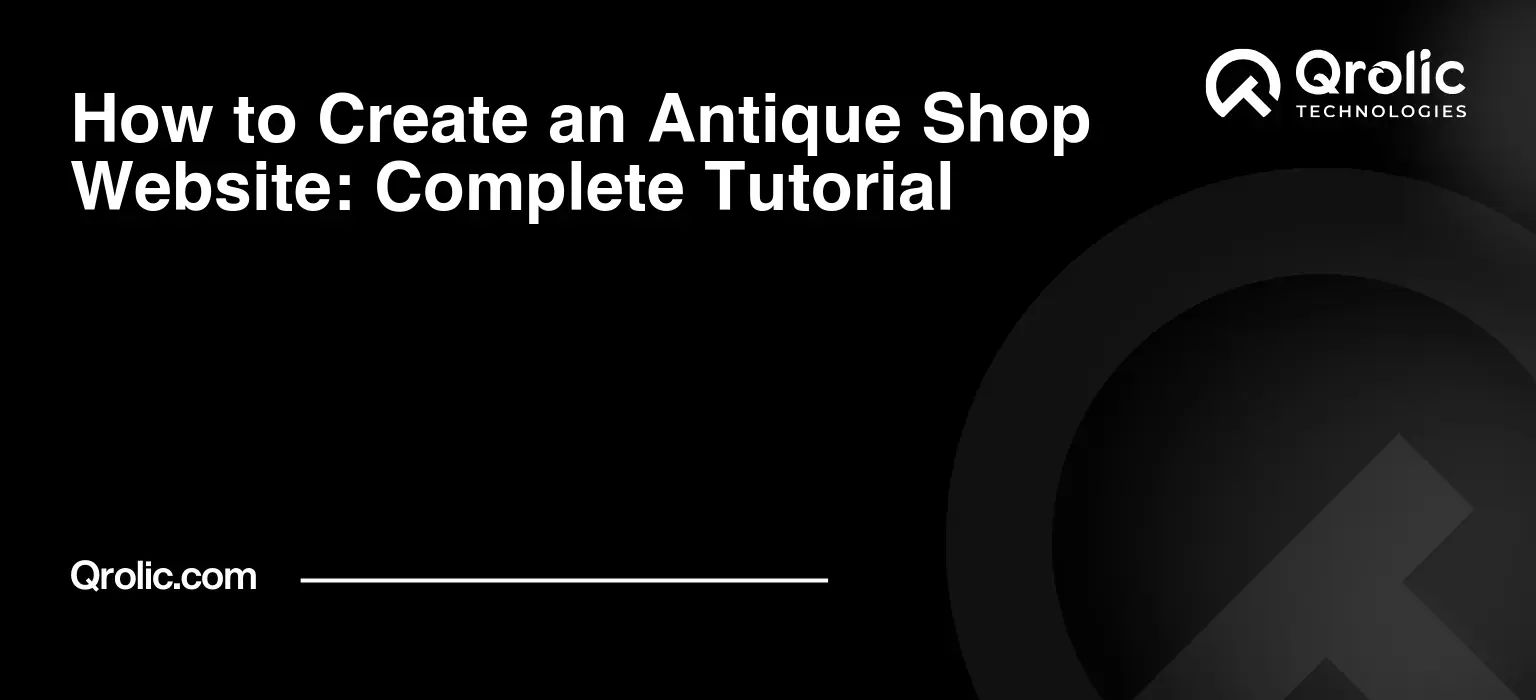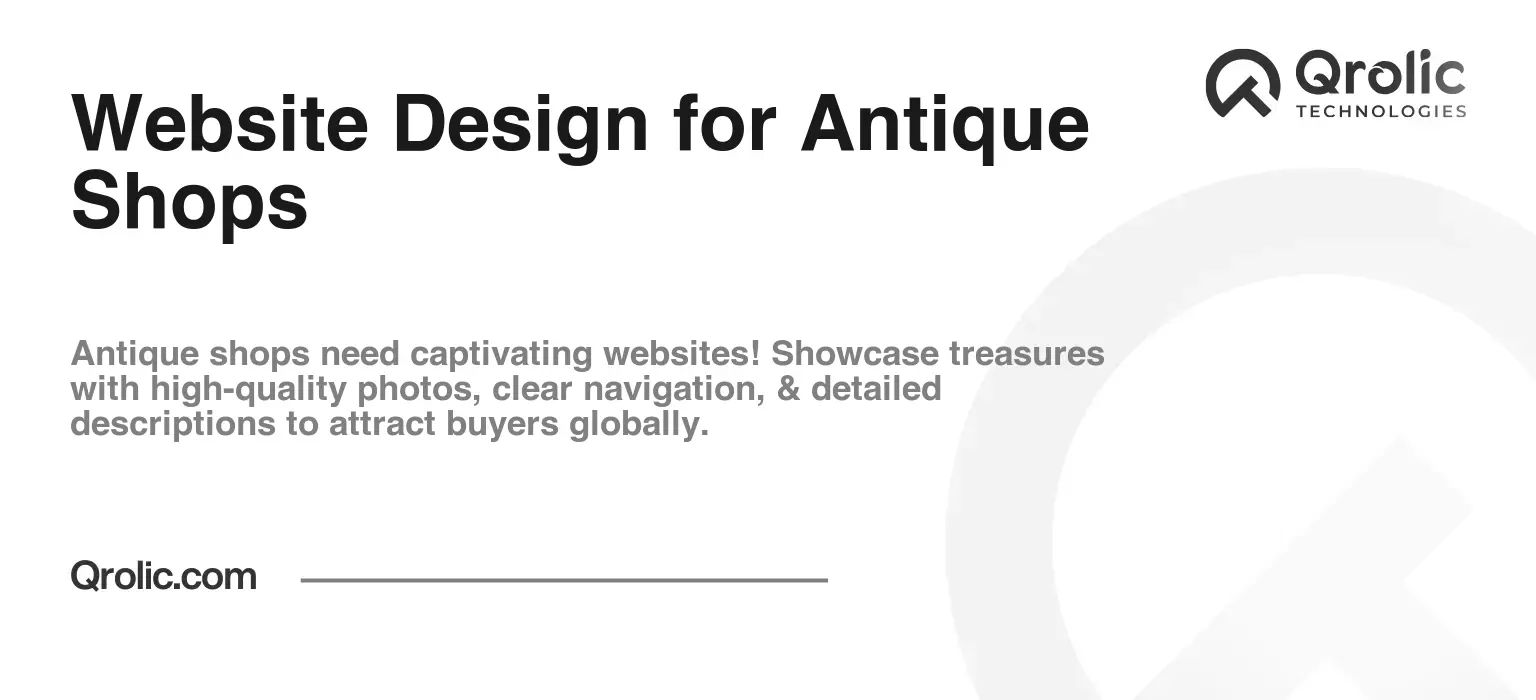Quick Summary:
- Create a beautiful, easy-to-use, and mobile-friendly website.
- Use high-quality photos and detailed stories for each antique.
- Optimize your site for search engines to attract more visitors.
- Engage customers through social media, email, and live chat.
Table of Contents
- The Allure of Authenticity: Why Antique Shops Need a Powerful Online Presence
- I. First Impressions Matter: The Foundation of Your Antique Website
- A. Visually Stunning Design: Capturing the Essence of Antiques
- B. Storytelling and Context: Adding Value Beyond the Product
- C. Building Trust and Credibility: Reassuring Your Customers
- II. The Heart of Your Website: The Antique Catalog
- A. High-Quality Images and Detailed Descriptions: The Dynamic Duo
- B. Organization and Filtering: Making it Easy to Find Treasures
- C. Enhancing the User Experience: Adding Delight and Convenience
- III. Engaging with Your Audience: Building Relationships and Driving Sales
- A. Inquiry Forms: Capturing Leads and Providing Personalized Service
- B. Email Marketing: Nurturing Leads and Promoting New Arrivals
- C. Social Media Integration: Expanding Your Reach and Building Community
- D. Live Chat: Providing Real-Time Support and Closing Deals
- IV. The Back-End Powerhouse: Essential Functionality for Managing Your Antique Shop Website
- A. Inventory Management System: Keeping Track of Your Treasures
- B. E-commerce Platform: Secure and Seamless Transactions
- C. Analytics and Reporting: Measuring Your Success and Optimizing Your Performance
- V. SEO for Antique Shops: Getting Found Online
- A. Keyword Research: Understanding What Your Customers Are Searching For
- B. On-Page Optimization: Making Your Website Search Engine Friendly
- C. Off-Page Optimization: Building Authority and Earning Backlinks
- VI. The Role of Qrolic Technologies in Building Your Antique Shop’s Online Success
- VII. Legal Considerations for Selling Antiques Online
- A. Authenticity and Provenance: Ensuring Accuracy and Disclosure
- B. Copyright and Intellectual Property: Respecting Ownership Rights
- C. Sales Tax and Customs Regulations: Navigating International Transactions
- VIII. The Future of Antique Shops Online: Embracing Innovation
- A. Virtual Reality (VR) and Augmented Reality (AR): Immersive Experiences
- B. Artificial Intelligence (AI): Personalized Recommendations and Customer Service
- C. Blockchain Technology: Enhancing Trust and Transparency
- IX. Conclusion: Crafting a Digital Legacy for Your Antique Shop
The Allure of Authenticity: Why Antique Shops Need a Powerful Online Presence
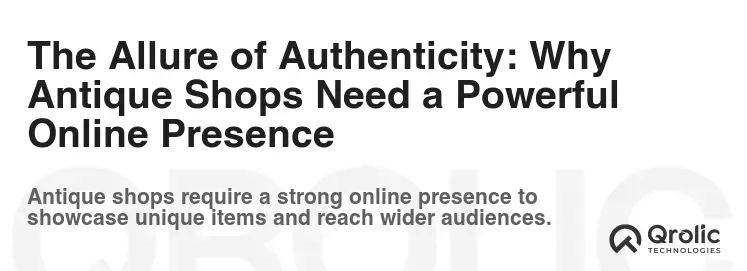
In a world saturated with mass-produced goods, the allure of antiques – objects imbued with history, craftsmanship, and a unique story – is stronger than ever. But simply having a physical shop overflowing with treasures isn’t enough in today’s digital age. To truly thrive, antique shops need a robust and engaging online presence, starting with a website that captures the magic and mystery of the antique world. This article explores the essential website features that will transform your antique shop’s online presence, attracting collectors, enthusiasts, and curious newcomers alike.
I. First Impressions Matter: The Foundation of Your Antique Website

A. Visually Stunning Design: Capturing the Essence of Antiques
Your website’s design is your digital storefront. It’s the first thing potential customers see, and it needs to immediately convey the character and quality of your antique shop.
-
High-Quality Photography: This is non-negotiable. Invest in professional-grade photography that showcases your antiques in their best light. Use multiple angles, close-ups, and lifestyle shots to provide a comprehensive view. Remember, customers can’t physically examine the items, so your photos need to do the talking. This is the first place you should focus when optimizing the image search on antique store website.
- Example: Instead of a single, poorly lit photo of a Victorian chair, include images showing the intricate carving, the fabric texture, the chair’s profile, and how it might look in a stylish living room setting.
-
Elegant and Intuitive Navigation: A cluttered or confusing website will send visitors running. Ensure your site is easy to navigate, with clear categories, search functionality, and a logical layout.
- Best Practices: Use drop-down menus for categories like “Furniture,” “Jewelry,” “Art,” and “Collectibles.” Implement a robust search feature allowing users to search by keyword, era, style, or material.
-
Mobile-Friendly Design (Responsive Design): With the majority of online browsing happening on mobile devices, a responsive design is crucial. Your website must adapt seamlessly to different screen sizes and resolutions.
- Why it matters: A website that’s difficult to navigate on a smartphone will frustrate users and lead to lost sales.
-
Consistent Branding: Maintain a consistent brand identity across your website, social media, and physical shop. Use your logo, color palette, and typography to create a cohesive and recognizable brand.
-
Website Speed Optimization: slow loading times kill conversions. Optimize images, leverage browser caching, and choose a reliable hosting provider to ensure your website loads quickly.
B. Storytelling and Context: Adding Value Beyond the Product
Antiques aren’t just objects; they’re vessels of history and stories. Your website should bring these stories to life.
-
Detailed Product Descriptions: Go beyond basic dimensions and materials. Tell the story of each antique: its origin, its history, its unique features, and its potential place in a collector’s world.
- Example: Instead of just saying “Victorian silver teapot,” write: “This exquisite Victorian silver teapot, hallmarked for Sheffield in 1888, is a testament to the elegance of the era. Its intricate floral engravings and delicate spout make it a perfect addition to any tea lover’s collection. It comes with a certificate of authenticity and a detailed history of the silversmith who created it.”
-
Blog Posts and Articles: Create informative and engaging content about antiques, collecting, and related topics. This will attract visitors, establish your expertise, and improve your search engine ranking.
- Content Ideas: “A Beginner’s Guide to Identifying Antique Furniture,” “The History of Art Deco Jewelry,” “How to Care for Your Antique Silver Collection,” “The Most Sought-After Collectibles of 2024.”
- Behind-the-Scenes Content: Showcase your expertise and passion for antiques by sharing behind-the-scenes glimpses of your shop, your restoration process, and your sourcing trips.
- Expert Opinions and Appraisals: Offer expert opinions and appraisal services to establish credibility and attract potential sellers.
C. Building Trust and Credibility: Reassuring Your Customers
Buying antiques online requires a leap of faith. Build trust by showcasing your expertise, providing clear information, and ensuring secure transactions.
- About Us Page: Tell your story, share your passion for antiques, and highlight your experience and expertise. Include photos of your team and your shop.
- Testimonials and Reviews: Showcase positive reviews and testimonials from satisfied customers. Consider using a third-party review platform to ensure authenticity.
- Security Badges and Certifications: Display security badges and certifications to reassure customers that their transactions are secure.
- Clear Return Policy: Outline your return policy clearly and concisely. This will give customers confidence and reduce the risk of disputes.
- Contact Information: Make it easy for customers to contact you with questions or concerns. Include your phone number, email address, physical address (if applicable), and a contact form.
II. The Heart of Your Website: The Antique Catalog
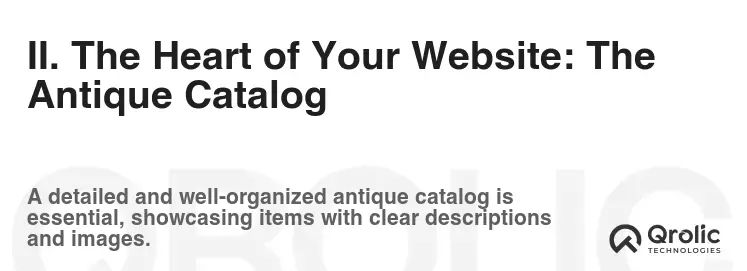
The catalog is the core of your antique store website. It’s where you showcase your inventory and entice customers to browse and buy.
A. High-Quality Images and Detailed Descriptions: The Dynamic Duo
- Multiple Images: Provide multiple high-resolution images of each item, showcasing it from different angles and highlighting its unique features. Use zoom functionality to allow customers to examine details closely.
- 360-Degree Views (Optional): Consider using 360-degree views for certain items to provide an even more immersive experience.
- Detailed Specifications: Include detailed specifications for each item, such as dimensions, materials, condition, provenance, and any known history.
- Condition Reports: Provide honest and accurate condition reports, highlighting any flaws or imperfections. Transparency is key to building trust.
- Keywords and Search Engine Optimization: Optimize your product descriptions with relevant keywords to improve your search engine ranking. Use keywords that potential customers are likely to search for, such as “Victorian armchair,” “Art Deco necklace,” or “antique silver teapot.” This is the second place you should focus when optimizing the image search on antique store website.
B. Organization and Filtering: Making it Easy to Find Treasures
- Categorization: Organize your inventory into logical categories and subcategories to make it easy for customers to browse.
- Filtering Options: Implement filtering options that allow customers to narrow their search by price, era, style, material, condition, and other relevant criteria.
- Sorting Options: Allow customers to sort items by price, date added, popularity, or other criteria.
- Search Functionality: A robust search function is essential for allowing customers to quickly find specific items. Implement auto-suggest functionality to help users refine their searches.
- Tagging: Use tags to categorize items by theme, style, or other relevant attributes. This allows customers to easily find related items.
C. Enhancing the User Experience: Adding Delight and Convenience
- Zoom Functionality: Allow customers to zoom in on images to examine details closely.
- Lightboxes: Use lightboxes to display images in a larger format without leaving the product page.
- Related Items: Suggest related items that customers might be interested in. This can increase sales and encourage exploration.
- Wish Lists: Allow customers to save items to a wish list for later purchase.
- Compare Items: Allow customers to compare multiple items side-by-side.
- Printable Information: Provide a printable version of the product description and images.
III. Engaging with Your Audience: Building Relationships and Driving Sales

Your website isn’t just a catalog; it’s a platform for engaging with your audience, building relationships, and driving sales.
A. Inquiry Forms: Capturing Leads and Providing Personalized Service
- Simple and Accessible: Make your inquiry form easy to find and fill out. Keep the number of fields to a minimum to avoid deterring potential customers.
- Detailed Information: Include fields for name, email address, phone number (optional), item of interest, and a message box for specific questions or requests.
- Image Upload: Allow customers to upload images of items they are interested in selling or having appraised.
- Automated Responses: Set up automated responses to acknowledge receipt of inquiries and provide estimated response times.
- Prompt and Personalized Responses: Respond to inquiries promptly and provide personalized service. Address customers by name and answer their questions thoroughly.
B. Email Marketing: Nurturing Leads and Promoting New Arrivals
- Email Signup Forms: Offer a prominent email signup form on your website. Consider offering a discount or other incentive to encourage signups.
- Segmented Email Lists: Segment your email lists based on customer interests and purchase history to send targeted and relevant messages.
- Regular Newsletters: Send regular newsletters featuring new arrivals, special promotions, blog posts, and other relevant content.
- Automated Email Campaigns: Set up automated email campaigns for new subscribers, abandoned carts, and post-purchase follow-up.
- Personalized Emails: Personalize your emails with customer names and relevant product recommendations.
C. Social Media Integration: Expanding Your Reach and Building Community
- Social Media Links: Include links to your social media profiles on your website.
- Social Sharing Buttons: Add social sharing buttons to your product pages and blog posts to make it easy for customers to share your content.
- Social Media Feed: Embed your social media feed on your website to showcase your latest posts and updates.
- Run Social Media Contests: Run social media contests and promotions to engage your audience and drive traffic to your website.
- Engage with Your Followers: Respond to comments and messages on social media promptly and engage with your followers to build a strong community.
D. Live Chat: Providing Real-Time Support and Closing Deals
- 24/7 Availability (Optional): Consider offering 24/7 live chat support to cater to customers in different time zones.
- Trained Representatives: Ensure your live chat representatives are knowledgeable about your inventory and can answer customer questions accurately and efficiently.
- Proactive Chat Invitations: Use proactive chat invitations to engage with visitors who are browsing specific product pages.
- Personalized Recommendations: Provide personalized product recommendations based on customer inquiries and browsing history.
- Collect Feedback: Use live chat to collect feedback from customers and identify areas for improvement.
IV. The Back-End Powerhouse: Essential Functionality for Managing Your Antique Shop Website
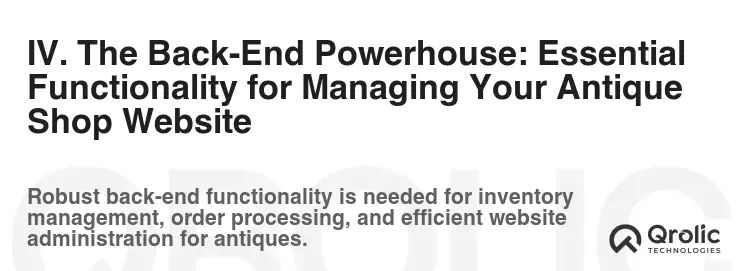
A beautiful front-end is only half the battle. You also need a powerful back-end to manage your inventory, process orders, and track your performance.
A. Inventory Management System: Keeping Track of Your Treasures
- Centralized Database: A centralized database for managing your entire inventory, including product descriptions, images, specifications, and condition reports.
- Stock Tracking: Track stock levels and receive alerts when items are running low.
- Automated Updates: Automatically update inventory levels when items are sold or added.
- Reporting and Analytics: Generate reports on inventory levels, sales trends, and other key metrics.
- Integration with E-commerce Platform: Seamless integration with your e-commerce platform to ensure accurate inventory information is displayed on your website.
B. E-commerce Platform: Secure and Seamless Transactions
- Secure Payment Gateway: Integrate with a secure payment gateway to process credit card payments safely and securely.
- Multiple Payment Options: Offer multiple payment options, such as credit cards, PayPal, and Apple Pay.
- Order Management System: Manage orders efficiently, including order tracking, shipping updates, and customer communication.
- Shipping Integration: Integrate with shipping providers to calculate shipping costs and generate shipping labels.
- Sales Tax Calculation: Automatically calculate sales tax based on customer location.
C. Analytics and Reporting: Measuring Your Success and Optimizing Your Performance
- Website Traffic Analysis: Track website traffic, bounce rates, and other key metrics to understand how visitors are interacting with your website.
- Conversion Tracking: Track conversion rates to measure the effectiveness of your marketing campaigns and identify areas for improvement.
- Sales Tracking: Track sales data to understand which products are selling well and identify trends.
- Customer Behavior Analysis: Analyze customer behavior to understand how customers are browsing your website and making purchasing decisions.
- A/B Testing: Use A/B testing to experiment with different website designs and features to optimize your performance.
V. SEO for Antique Shops: Getting Found Online

Having a great website is useless if no one can find it. Search Engine Optimization (SEO) is crucial for driving traffic to your website and attracting potential customers.
A. Keyword Research: Understanding What Your Customers Are Searching For
- Identify Relevant Keywords: Identify the keywords that potential customers are likely to search for when looking for antiques. Use keyword research tools to find high-volume, low-competition keywords.
- Long-Tail Keywords: Focus on long-tail keywords, which are longer and more specific phrases that target a more niche audience.
- Competitor Analysis: Analyze your competitors’ websites to identify the keywords they are targeting.
- Local SEO: Focus on local SEO keywords to attract customers in your local area.
B. On-Page Optimization: Making Your Website Search Engine Friendly
- Title Tags and Meta Descriptions: Optimize your title tags and meta descriptions with relevant keywords to improve your click-through rate in search results.
- Header Tags: Use header tags (H1, H2, H3, etc.) to structure your content and highlight important keywords.
- Image Alt Text: Add alt text to your images to describe the image to search engines. Use relevant keywords in your alt text.
- Internal Linking: Link to other relevant pages on your website to improve your website’s structure and navigation.
- Content Optimization: Optimize your content with relevant keywords and provide valuable information to your audience.
C. Off-Page Optimization: Building Authority and Earning Backlinks
- Link Building: Build high-quality backlinks from other websites to improve your website’s authority and ranking in search results.
- Directory Submissions: Submit your website to relevant online directories.
- Social Media Marketing: Promote your website and content on social media to increase your reach and visibility.
- Guest Blogging: Write guest posts for other websites in your industry to build backlinks and establish your expertise.
- Online Reviews: Encourage customers to leave reviews on Google My Business and other review platforms.
VI. The Role of Qrolic Technologies in Building Your Antique Shop’s Online Success
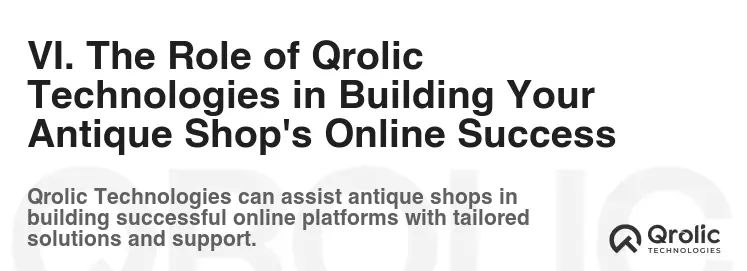
Qrolic Technologies (https://qrolic.com/) understands the unique needs of antique shops and can provide tailored solutions to help you build a successful online presence. With expertise in web design, e-commerce development, SEO, and digital marketing, Qrolic Technologies can help you:
- Develop a visually stunning and user-friendly website that captures the essence of your antique shop.
- Create a robust and engaging online catalog that showcases your inventory in its best light.
- Implement effective SEO strategies to drive traffic to your website and attract potential customers.
- Manage your online marketing campaigns and build a strong brand presence.
- Provide ongoing support and maintenance to ensure your website is always up-to-date and performing at its best.
Qrolic Technologies offers customized solutions based on your specific needs and budget, ensuring that you get the best possible return on your investment. Contact Qrolic Technologies today to learn more about how they can help you transform your antique shop’s online presence and achieve your business goals.
VII. Legal Considerations for Selling Antiques Online
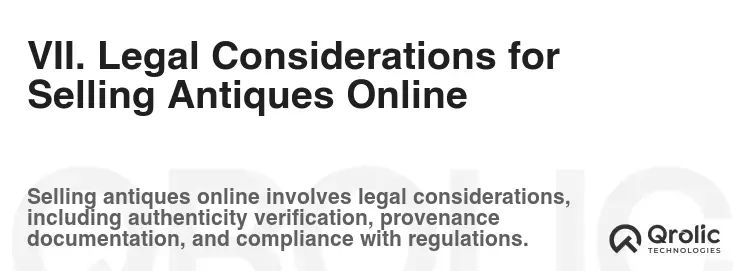
Selling antiques online involves certain legal considerations that you need to be aware of to avoid potential problems.
A. Authenticity and Provenance: Ensuring Accuracy and Disclosure
- Due Diligence: Conduct thorough due diligence to verify the authenticity and provenance of the antiques you sell.
- Accurate Descriptions: Provide accurate and detailed descriptions of each item, including its origin, history, materials, and condition.
- Disclosure of Alterations and Repairs: Disclose any alterations or repairs that have been made to the item.
- Certificates of Authenticity: Provide certificates of authenticity for valuable or rare items.
- Guarantees: Offer guarantees of authenticity and provenance.
B. Copyright and Intellectual Property: Respecting Ownership Rights
- Copyrighted Images: Obtain permission to use copyrighted images of antiques.
- Trademarked Names: Avoid using trademarked names in your product descriptions or marketing materials without permission.
- Intellectual Property Rights: Respect the intellectual property rights of artists and designers.
C. Sales Tax and Customs Regulations: Navigating International Transactions
- Sales Tax: Collect and remit sales tax as required by law.
- Customs Regulations: Comply with customs regulations when selling antiques internationally.
- Import and Export Restrictions: Be aware of any import or export restrictions on certain types of antiques.
- Disclosure of Fees and Taxes: Disclose all applicable fees and taxes to customers before they make a purchase.
VIII. The Future of Antique Shops Online: Embracing Innovation
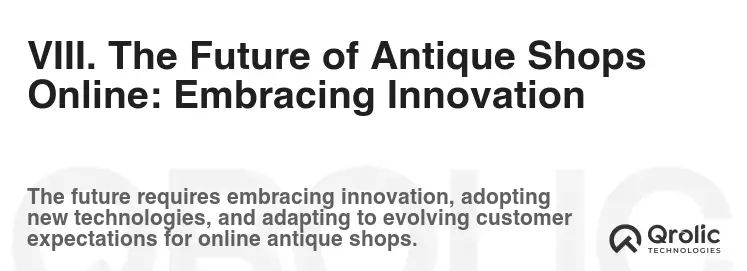
The online landscape is constantly evolving, and antique shops need to embrace innovation to stay ahead of the curve.
A. Virtual Reality (VR) and Augmented Reality (AR): Immersive Experiences
- Virtual Tours: Offer virtual tours of your shop to allow customers to explore your inventory from the comfort of their own homes.
- AR Apps: Develop AR apps that allow customers to visualize how antiques would look in their own homes.
- 3D Models: Create 3D models of antiques that customers can interact with online.
B. Artificial Intelligence (AI): Personalized Recommendations and Customer Service
- AI-Powered Chatbots: Use AI-powered chatbots to provide 24/7 customer service and answer common questions.
- Personalized Recommendations: Use AI to provide personalized product recommendations based on customer browsing history and purchase patterns.
- Image Recognition: Use image recognition technology to identify antiques from customer-submitted photos.
C. Blockchain Technology: Enhancing Trust and Transparency
- Provenance Tracking: Use blockchain technology to track the provenance of antiques and ensure their authenticity.
- Secure Transactions: Use blockchain technology to secure online transactions and prevent fraud.
- Digital Certificates: Issue digital certificates of authenticity using blockchain technology.
IX. Conclusion: Crafting a Digital Legacy for Your Antique Shop
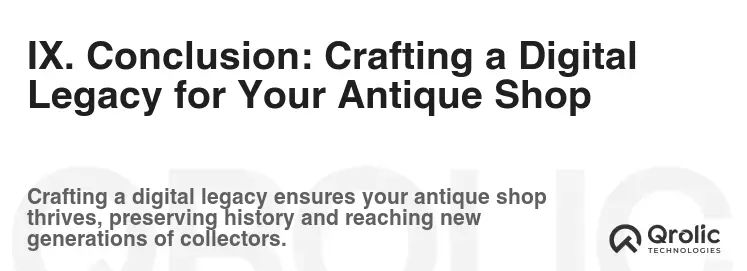
Creating a successful online presence for your antique shop requires more than just a website. It requires a deep understanding of your target audience, a commitment to quality and authenticity, and a willingness to embrace innovation. By implementing the features and strategies outlined in this article, you can transform your website into a powerful tool for attracting collectors, building relationships, and preserving the legacy of the past for generations to come. Remember to always focus on providing a superior user experience, building trust and credibility, and leveraging the power of digital marketing to reach your target audience. And don’t hesitate to seek the expertise of companies like Qrolic Technologies to help you navigate the complex world of online marketing and achieve your business goals.

